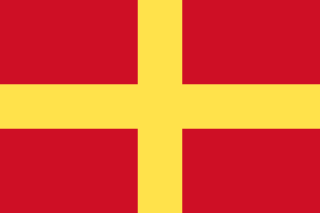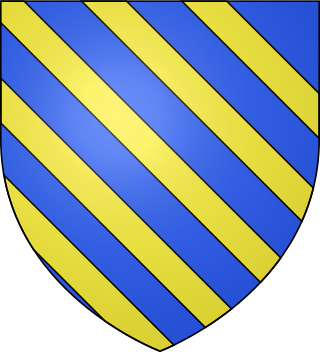Related Research Articles

Aimery of Lusignan, erroneously referred to as Amalric or Amaury in earlier scholarship, was the first King of Cyprus, reigning from 1196 to his death. He also reigned as the King of Jerusalem from his marriage to Isabella I in 1197 to his death. He was a younger son of Hugh VIII of Lusignan, a nobleman in Poitou. After participating in a rebellion against Henry II of England in 1168, he went to the Holy Land and settled in the Kingdom of Jerusalem.

Peter, also Peter II of Courtenay, was emperor of the Latin Empire of Constantinople from 1216 to 1217.

The County of Tripoli (1102–1289) was the last of the Crusader states. It was founded in the Levant in the modern-day region of Tripoli, northern Lebanon and parts of western Syria. When the Frankish Crusaders – mostly southern French forces – captured the region in 1109, Bertrand of Toulouse became the first count of Tripoli as a vassal of King Baldwin I of Jerusalem. From that time, the rule of the county was decided not strictly by inheritance but by factors such as military force, favour and negotiation. In 1289 the County of Tripoli fell to Sultan Qalawun of the Muslim Mamluks of Cairo. The county was absorbed into Mamluk Egypt.

Henry I of Cyprus, nicknamed the Fat was King of Cyprus from 1218 to 1253. He was the son of Hugh I of Cyprus and Alice of Champagne. When his father Hugh I died on January 10, 1218, the 8-month-old Henry became king. His mother was the official regent, but handed off the actual governing to her uncle, Philip of Ibelin. When Philip died, the effective regency passed to his brother, John of Ibelin, the Old Lord of Beirut.
Bohemond VI, also known as the Fair, was the prince of Antioch and count of Tripoli from 1251 until his death. He ruled while Antioch was caught between the warring Mongol Empire and Mamluk Sultanate. He allied with the Mongols against the Muslim Mamluks and his Crusaders fought alongside the Mongols in their battles against the Mamluks. The Mamluks would achieve a historic victory against the Mongols and halt their advance westwards at the Battle of Ain Jalut. In 1268 Antioch was captured by the Mamluks under Baybars, and he was thenceforth a prince in exile. He was succeeded by his son, Bohemond VII.

The Crusader state of the Kingdom of Jerusalem, created in 1099, was divided into a number of smaller seigneuries. According to the 13th-century jurist John of Ibelin, the four highest crown vassals in the kingdom proper were the count of Jaffa and Ascalon, the prince of Galilee, the lord of Sidon, and the lord of Oultrejordain.

Bohemond VII was the count of Tripoli and nominal prince of Antioch from 1275 to his death. The only part left of the once great Principality of Antioch was the port of Latakia. He spent much of his reign at war with the Templars (1277–1282).

The House of Ibelin was a noble family in the Crusader Kingdom of Jerusalem in the 12th century. They rose from humble beginnings to become one of the most important families in the kingdom, holding various high offices and with extensive holdings in the Holy Land and Cyprus. The family disappeared after the fall of the Kingdom of Cyprus in the 15th century.

Enguerrand III de Boves, Lord of Coucy was a medieval French nobleman. The eldest son and successor of Ralph I, Lord of Coucy and Alix de Dreux, he succeeded as Lord of Coucy in 1191, and held it until his death; he was also lord of Marle and Boves.

The Ramnulfids, or the House of Poitiers, were a French dynasty ruling the County of Poitou and Duchy of Aquitaine in the 9th through 12th centuries. Their power base shifted from Toulouse to Poitou. In the early 10th century, they contested the dominance of northern Aquitaine and the ducal title to the whole with the House of Auvergne. In 1032, they inherited the Duchy of Gascony, thus uniting it with Aquitaine. By the end of the 11th century, they were the dominant power in the southwestern third of France. The founder of the family was Ramnulf I, who became count in 835.

The Embriaco were a prominent Genoese family, who played an important role in the history of the Crusader states. It also gave consuls, admirals and ambassadors to the Republic of Genoa.
Plaisance of Gibelet was the daughter of Hugh III Embriaco, Lord of Gibelet, and Stephanie of Milly.

The Fall of Tripoli was the capture and destruction of the Crusader state, the County of Tripoli, by the Muslim Mamluks. The battle occurred in 1289 and was an important event in the Crusades, as it marked the capture of one of the few remaining major possessions of the Crusaders. The event is represented in a rare surviving illustration from a now fragmentary manuscript known as the 'Cocharelli Codex', thought to have been created in Genoa in the 1330s. The image shows the countess Lucia, Countess of Tripoli and Bartholomew, Bishop of Tortosa sitting in state in the centre of the fortified city, and Qalawun's assault in 1289, with his army depicted massacring the inhabitants fleeing to boats in the harbour and to the nearby island of St Thomas.
Peter Embriaco of Gibelet, lord of the fief of Gibelet, was the last prince of the House of Giblet in the Levant.

William II, Lord of Béthune, nicknamed William the Red was French nobleman. He was a ruling Lord of Béthune, Richebourg and Warneton, as well as hereditary advocatus of the Abbey of St. Vaast, near Arras.
Stéphanie of Milly, was a noblewoman of the Crusades.
Hugo or Hugh l’Aleman was a nobleman of the Kingdom of Jerusalem.

Hugues de Revel was an English knight who became the twentieth Grand Master of the Knights Hospitaller, serving from 1258 to 1277 as the successor to Guillaume de Chateauneuf. He was succeeded by Nicolas Lorgne.
Guy II or Guido II, surnamed Embriaco, was the lord of Gibelet from about 1271 until his death.
William of Botron was Lord of Botron (1244–1262) in the County of Tripoli, and Constable of Jerusalem (1258–1262).
References
- ↑ Je m'appelle Byblos, Jean-Pierre Thiollet, H & D, 2005. ISBN 2-914266-04-9.